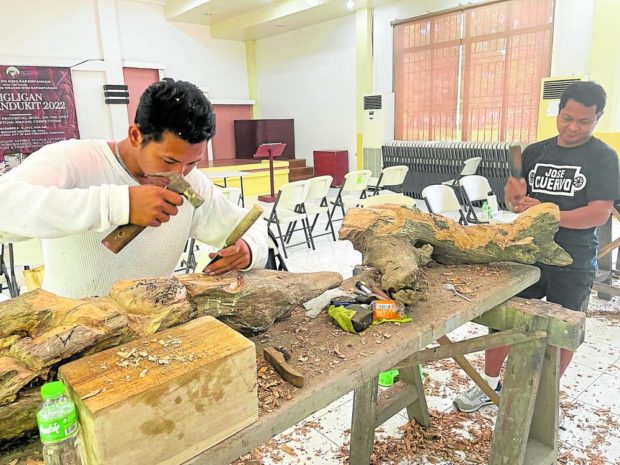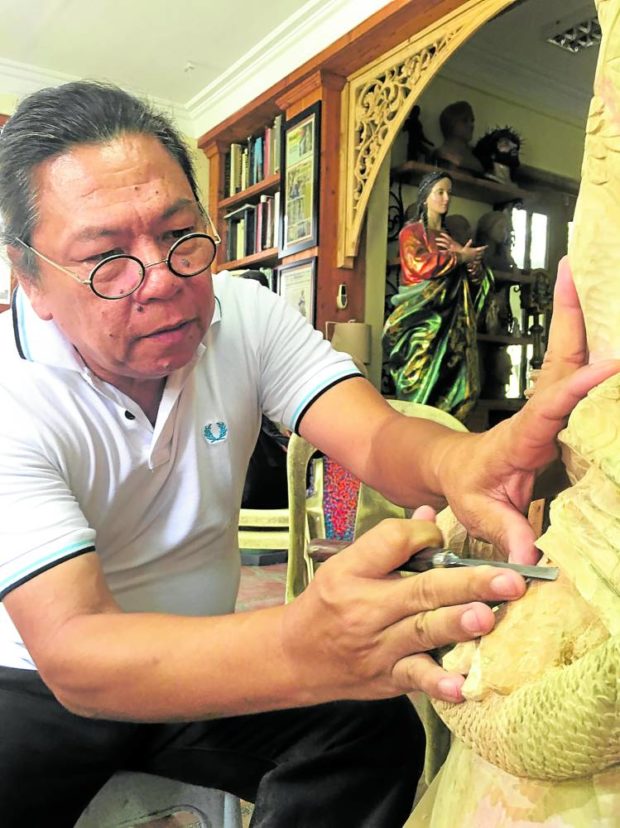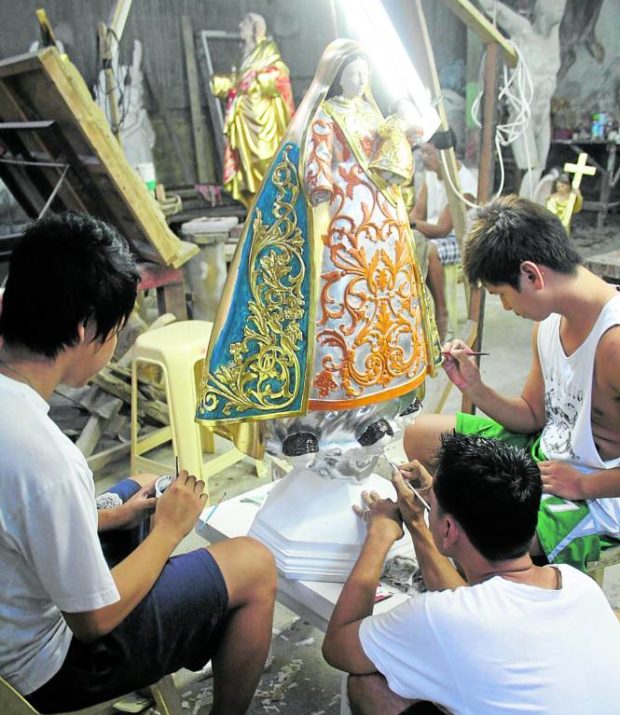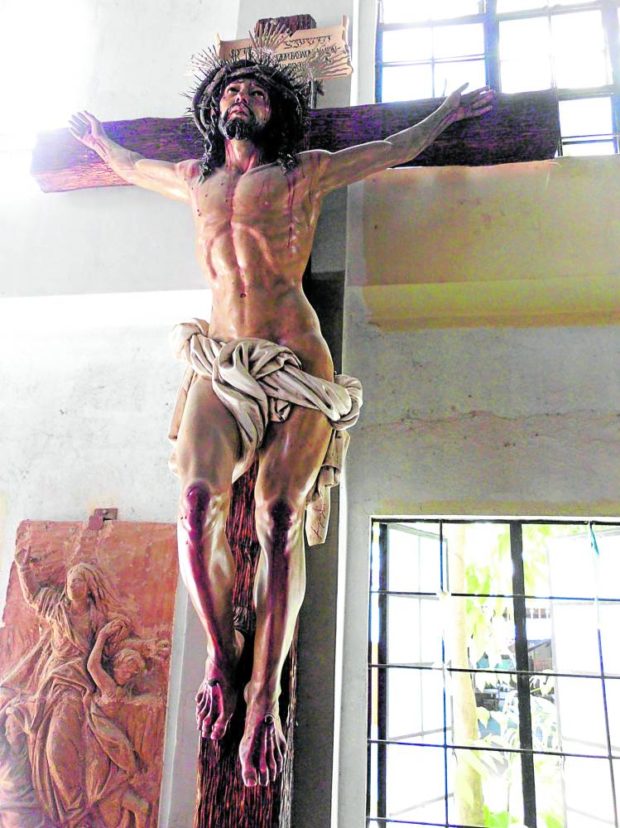In Pampanga, ‘mandukit’ carve their path from Betis to capitol

GENERATIONAL LEARNING | Men in Betis in Guagua town learn the art and techniques of woodcarving through their fathers, uncles or neighbors amid a lack of formal school or apprenticeship. (Photo by TONETTE OREJAS / Inquirer Central Luzon)
CITY OF SAN FERNANDO, Pampanga, Philippines — Ahead of the 451st anniversary of Spain’s inauguration of Pampanga as the first province in Luzon, 10 men who call themselves “mandukit” (woodcarvers) or “iscultor” (sculptors) set foot at the provincial capitol here on Thursday.
By their body language, the three older men obviously wear their pride through a wide grin and sure gait. The seven other men in their 30s to 50s stoop awkwardly.
As they fill the Benigno S. Aquino Hall, each one picks by lot a molave and narra trunk. In no time, they set up their own workshops, placing the old disfigured wood on top of wooden planks.
Then they keenly gaze at the pieces after Wilfredo “Willy” Layug announces that Kapampangan culture and tradition would be the theme of the woodwork. Layug is the artistic director of what is called Ligligan Pamandukit (on-the-spot sculpture-making competition).
This is the first time that a contest of this sort is held for the celebration of Aldo ning Kapampangan (Pampanga Day) on Dec. 11, when the Most Outstanding Kapampangan Award is bestowed, the Mutya ning Kapampangan pageant is held and food bazaars and sociocivic activities are mounted.
Article continues after this advertisementWith chalk in hand, Nick Lugue, Jayper Rubio, Francisco Sibug, Prince Renie Layug, Alberto Pangilinan, Daniel Carpio, Jesus Santos, Rofel Sobrepeña, Alexander Bisda, and Rozaldo Franche of the village of Betis in Guagua town draw the outlines of their images.
Article continues after this advertisementThen they arrange their “pait” (carving tools). Soon, the hall is filled with sounds of wood being chiseled, shaved, cut, chipped off, or smoothened.

RELIGIOUS ART | Wilfredo “Willy” Layug elevated religious art in Betis in Guagua town by studying techniques from masters in Seville, Spain, sharing these with local sculptors. (Photo by TONETTE OREJAS / Inquirer Central Luzon)
‘Big leap’
On Friday night, visual artists Ed Coronel, Alvaro Jimenez, and Sariel Armando Ancheta pick the winning pieces made by Franche, Prince Renie Layug, and Rubio, earning them cash prizes and certificates.
Layug regards the event a “big leap” from the wood carving festival he and the Mandukit Aluagi of Sta. Ursula (Masu) have been holding yearly in Betis, an ancient Muslim settlement with seven villages that were attached to the younger town of Guagua in 1904.
Provincial Board Member Mylyn Pineda-Cayabyab says she included the event in the weeklong celebration “as a form of support to Kapampangan artists who struggled to survive during [COVID-19] pandemic.”
“Mr. Layug and the Betis artisans have been trying to save the art of woodcarving from dying. They have been doing the Dukit Festival for 10 years now, and they want to train young people to be able to preserve the craft,” Cayabyab says.
The point of origin, even for Lugue of Apalit town and Rubio of Bacolor town, is Barangay Sta. Ursula, known in olden times as Paglalabuan after the Labuan River that flows to Manila Bay.
Their fathers picked up the craft from friends in the village and practiced it in their respective towns. Many of them grew up in the midst of the craft. Layug’s own father, Alfonso, shifted to carving furniture and religious arts after years of boat-making (“mandaras”).
Sobrepeña and Prince Renie Layug, both 27 and the youngest participants, began carving “muebles” (furniture) and “santos” (images of saints) while they were in high school, their mentors being their fathers, uncles and older neighbors.
Jesus Santos, 67, began carving at 12 because the whole village of Sta. Ursula relied on the same skills for a living.
“What is amazing is that we can create something good from wood that is given by Mother Nature,” Pangilinan, 66, tells the Inquirer.
In the third year of the pandemic, village chief Estrelita Pacia says Sta. Ursula (population: over 5,000) still has around 200 artisans.

Young men gilding gold for a technique called “estofado,” making it appear that wooden images wear clothes. (Photo by TONETTE OREJAS / Inquirer Central Luzon)
Dwindling number
But recently, only a little over 100 are actively practicing the craft, says Layug, who organized Masu in 2012.
Some have set up stores and workshops along the Bacolor and Guagua portions of Jose Abad Santos Avenue (formerly Gapan-San Fernando-Olongapo Road) to revive the business after Mt. Pinatubo’s 1991 eruption and lahar flows until 1997.
Sta. Ursula was the base of Juan Culala Flores who worked for master sculptors in Manila at the age of 16 to escape fishing (“mamyakus”). He was said to have returned at 19, revitalizing woodworking, giving jobs even to boys as he made the interior pieces in Malacañang since former President Manuel L. Quezon and up to the time of former first lady Imelda Marcos until he suffered a stroke in 1979, according to accounts by elders.
The tradition lived on as Flores trained many proteges who in turn passed the skills to their kin, producing generations of artists. After learning from his father, Layug trained his son Joseph.

ALTAR PIECE | Wilfredo “Willy” Layug made this cross for the altar of the Mass celebrated by Pope Francis in his visit to the Philippines in 2015. (Photo by TONETTE OREJAS / Inquirer Central Luzon)
Challenges
Betis is challenged by shortage of wood, competition from furniture makers in Indonesia, Malaysia, and China and little interest by the local youth to learn the craft, old-timers said. When the economy was bad, woodcarvers eked out a living by driving tricycles or working abroad as carpenters.
Layug is in a league all his own. He finished fine arts in the University of Santo Tomas and elevated ecclesiastical art by learning finer techniques like “estofado” and “encarna” from masters in Spain.
Estofado is a tedious painting and gilding process on wooden sculptures, giving off the impression that an icon is actually wearing real clothes. Polychromado is painting the face of a religious figure or encarna.
Layug received the Presidential Merit Awardee for Ecclesiastical Art from then-President Gloria Macapagal-Arroyo. Pope Francis gave him the Pro Ecclesia et Pontifice (For the Church and the Pope) medal in March 2016.
The first Ligligan Pamandukit might just be the “start of something big,” like forming a province-wide organization of artists, says Randy del Rosario, head of the arts, culture, and tourism office of Pampanga.
Fidel Sarmiento, then president of the Artists Association of the Philippines, gave this accolade in a past Dukit Festival: “You are not woodcarvers. You are sculptors.”